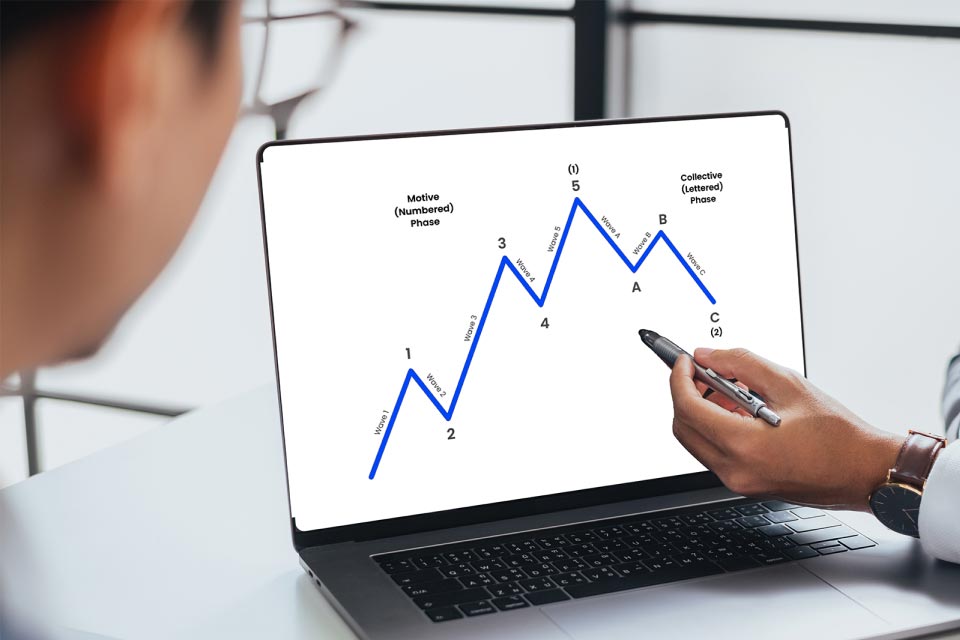The Elliott Wave Theory helps identify the market’s trend direction and provides ideal entry and exit points. It enables traders to predict future market movements and depict strong market trend sentiments. In this article, we take a look at what Elliott Waves are and how to use them in forex trading.
What is the Elliott Wave Theory?
The Elliott Wave Theory analyses a currency pair's long-term price movement in the forex market. It consists of recurring wave patterns that help in identifying extreme price levels. The ‘waves’ in the Elliott Wave Theory are actually the price levels of the currency pair. The Elliott Wave pattern is formed by five waves moving in the direction of the existing market trend and three waves against the market trend to signal ideal entry and exit price levels.
- The extreme high price in the market is expressed at level 5, where traders receive an exit signal
- The extreme low price in the market is expressed at level 2, where traders receive an entry singal
Types of Elliott Waves
1. Impulse waves
The impulse waves, also called motive waves, are the first five waves in the pattern that move with the current market trend. These five waves consist of three sub-waves in the upward direction and two sub-waves in the downward direction. It identifies the strongest market movement and the lowest price level to enable traders to take long or buy positions. The three rules without which the formation cannot be called an impulse wave are –
- The second wave can never retrace beyond 100% of the first wave
- The third wave is never the shortest of all the waves
- The fourth wave can never go beyond the third wave in the entire formation
2. Corrective waves
Corrective waves consist of three waves that move against the current market trend. These waves are made of one sub-wave in the upward direction and two sub-waves in the downward direction. It signifies that the market is correcting itself from the previous trend and identifies the highest price level in the market that enables traders to take short or sell positions.
- The first wave in this phase is less than 50% of the last wave
- The second wave (from A to B) is the smallest increase in prices in the entire formation
- The last wave (C) is always the longest in length and depicts the fall in the price movement
Top 4 Elliott Wave Patterns
1. Flat pattern
The flat pattern consists of three corrective waves, which have two sub-waves in the downward direction and one sub-wave in the upward direction. A and B waves are the corrective waves, moving against the market, whereas wave C is the impulse wave, moving along with the market. It helps traders identify corrective market movements and take entry and exit decisions accordingly.
- When the market is in a continued uptrend, the flat pattern identifies a downward market momentum, signalling traders to exit the market
- When the market is in a continued downtrend, the flat pattern identifies an upward market momentum, signalling traders to enter the market
2. Zig-zag pattern
The zig-zag pattern is another corrective wave made of three different waves that signal a strong upward or downward market direction. Here, wave A and wave C are impulse waves that move along with the market, whereas wave B is the corrective wave that moves against the market. These waves signal a sharp decline in a bullish market or a sharp incline in a bearish market.
- In a continued uptrend, the wave corrects the market by bringing the currency pair prices down and signal traders to take sell positions
- In a continued downtrend, the wave corrects the market by increasing the currency pair prices sharply and signal traders to take buy positions
3. Triangle pattern
The triangle pattern consists of five waves, A, B, C, D, and E, that make up a corrective pattern in the market to balance the current market direction. The sub-waves include three waves in the downward direction and two waves in the upward direction. The triangle can form a contraction, where the waves decrease in length as they continue, signifying that the price fluctuation starts with a strong increase and decrease before correcting the market and becoming stable. The triangle can also form an expansion, where the waves increase in length as they continue, signifying the same sharp price movements before the fluctuation settles down as the market is corrected.
- In a bullish market, these triangles signal traders to take short or sell positions as it corrects the market in its previous bearish position
- In a bearish market, these triangles signal traders to take long or buy positions as it corrects the market in its previously bullish position
4. Diagonal Pattern
The diagonal pattern looks like a contracting or expanding wedge with several waves forming in the pattern. This pattern is an impulse wave that moves in the direction of the market. It consists of five or more waves altogether and sub-waves that do not have a specific count. The diagonal pattern provides traders with a strong existing market momentum and signals them ideal entry or exit levels depending on if the market is bullish or bearish.
- In a bullish market, the diagonal pattern signals traders to take long or buy positions as the prices keep on expanding
- In a bearish market, the diagonal pattern signals traders to take short to sell positions as the prices keep on contracting
Trade using the Elliott Wave Theory today
The Elliott Wave Theory makes it easy for traders to trade with the market direction or against it, based on the impulse and corrective waves. Trade with Blueberry to experience unparalleled trading. Sign up for a live trading account or try a demo account on Blueberry Markets.









